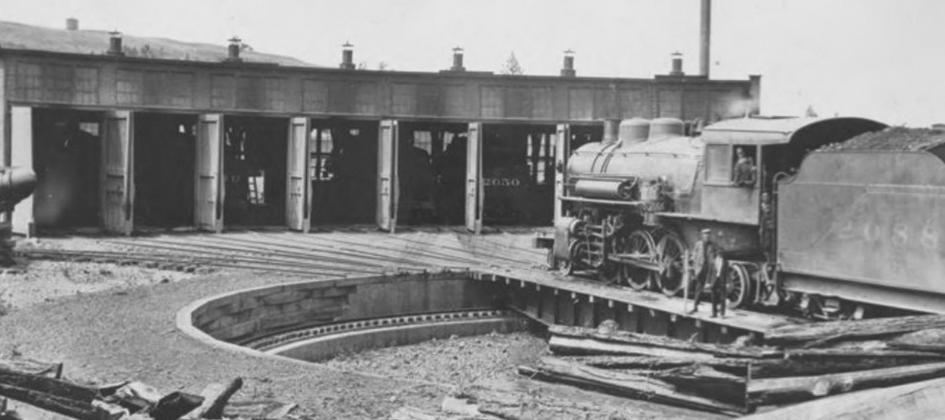(Part 2) On November 21, 1920, Jake Hamon, the rich oil man, railroad tycoon and politician was shot upstairs in the Randol Hotel while talking to his girlfriend. Jake, reeling in pain, came downstairs and collapsed in the dining room. He said that he was cleaning his gun when it went off. The girlfriend was tried for his death and ended up being declared not guilty in court. But his death must have left a financial mess behind with his railroad dealings. Things seemed to continue alright for a while, despite Jake Hamon’s death. (Wikipedia, Jake Hamon)
By early 1921, the roundhouse had been completed and was ready for inspection. 8 men were being brought to Dublin to work in the facility. Not all of the required equipment was here yet. The crew was here for a first run through to see if the facility was going the be beneficial to both the Frisco and Wichita Falls, Ranger and Fort Worth Railroad. (Dublin Progress, February 18, 1921)
The Santa Fe was looking to build a new trunk line through Oklahoma and was looking at Dublin as a place to connect with the Frisco Railroad. (November 3, 1922). This all pointed to Dublin being a destination and major railroad town.
There was a real problem with the Frisco Railroad having shops here and having a city street going right through the middle of the switching yard. So the Frisco Railroad decided to take the the City of Dublin to court with an injunction to close that road (Sheridan Street) that passed through the middle of the train yards. They said that it was impossible to operate the train yards and shops with automobile traffic passing through their switching yards. It would also allow children to wander into the shops without supervision and be injured. (Dublin Progress, February 25, 1921)
Financially things must have started changing after Jake Hamon’s death.
The Frisco Railroad, not having Jake’s financial backing, decided the roundhouse in Dublin was not going to be financially feasible, so the Frisco sent a crew to Dublin to start dismantling the roundhouse and closing the shops.
A suit was filed in Stephenville, to stop the dismantling of the roundhouse and to leave the turntable, extra track and to return to usable condition as originally promised. The Frisco Railroad had spent about $175,000 in building the roundhouse and associated equipment. The Frisco railroad said the Jake Hamon contract was not being acted on and economic conditions had changed making the shops no longer economically feasible. (Dublin Progress, May 19, 1922)
Because of the lack of financial backing after Jake Hamon’s death, the WFR&FW railroad decided to discontinue passenger service to Dublin. (Dublin Progress, May 19,1922)
The City of Dublin had a meeting in the Knights of Pythias Hall to see if citizens wanted to allow the railroad to remove the shops and leave Dublin. The school had an issue because land behind the high school had been donated to the railroad in order for the shops to be built. This affected the playgrounds and athletic fields behind the school that had been intended for football, baseball or any other athletics. The school’s original property went almost all the way east to the main line. The school had been told the land, donated to the railroad, would create new jobs adding extra tax revenue and benefit the school. With the shops gone the school would no longer have that benefit. That hurt the school because it was having to use land it did not own almost a mile north of the school as a football and athletic field. Also, the City of Dublin had invested $240,000 in helping establish the roundhouse shops. Mayor Fewell decided to send a committee to Austin with a petition to speak before the railroad commission. (Dublin Progress, February 9, 1923)
The court must have decided that the Frisco shops were no longer a viable option for Dublin. Community leaders started looking for other possibilities to make railroad repair shops a business in Dublin. Work by the city leaders was leaning toward getting the MKT railroads to move their railroad business to Dublin in an effort to salvage the limited hope that the shops could be saved.(Dublin Progress, August 4, 1922)
The woes between the Frisco and WFR&FW continued. During the time the downtown streets were being paved with brick, the Frisco Railroad said it was separating ties with the Wichita Falls, Ranger and Fort Worth. Frisco asked that the WFR&FW stop using their freight station and build their own. The WFR&FW complied with their request. The materials arrived on several flat cars in Dublin in 1926 and the building that is now part of the county tax office, served as the new WFR&FW freight station. (Dublin Progress, April 30, 1926)(Dublin Progress, May 28, 1926)
With the death of Jake Hamon, the railroad eventually went into receivership. The Wichita Falls and Southern purchased the railroad between Breckenridge and Dublin. On December 31, 1940, the name was changed to the Wichita Falls and Southern Railroad. It continued to operate carrying freight until 1954. A few Dublin citizens remember the turntable that was used. The locomotive would arrive in Dublin and had to be pushed around on the turntable by hand. I am told the railroad would pay anyone who could help, fifty cents for help turning the locomotive around. It apparently had a large piece of wood much like a cross tie that could be pushed to turn the locomotive.
Though the shops were big business back in the 1920s, only a dirt depression remains in the train yards of the Fort Worth and Western Railroad. Sheridan Street was eventually closed for the railroad almost 100 years later. The Randol Hotel burned in 1925.

